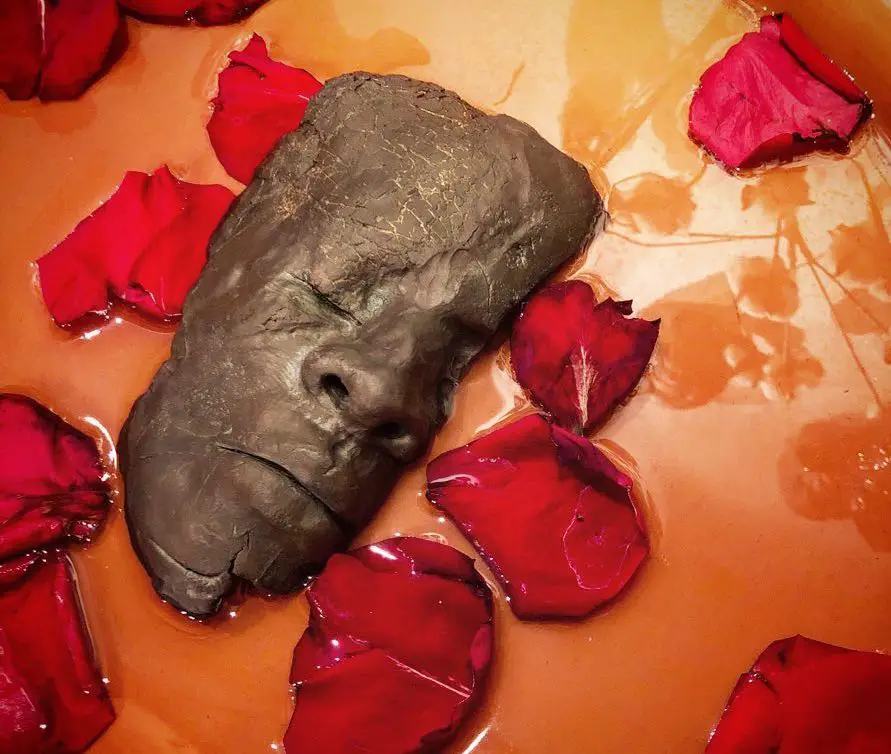The creator and their muse are as old as time immemorial. Artists have always found inspiration in others, whether it’s the women who sparked the creativity of Pablo Picasso, or Robert DeNiro, whom Martin Scorsese frequently collaborated with throughout his career.
Then there’s the painter, sculptor and performance artist Nikesha Breeze, who sculpted 108 jarringly real face-masks for a collection she calls “108 Death Masks: A Communal Prayer for Peace and Justice.” Last year, the project won the 3D Juried Grand Prize Award and the Contemporary Black Arts Award.
A queer African-American woman of Assyrian-Iranian heritage, Breeze has been on an artistic journey of the self, past and present, absorbing as many visual and oral histories as she can. Ultimately, her goal is for those images to manifest in her mind, allowing her to then realize them in canvas and clay.
Breeze’s deeply personal and meditative process is why her ancestral past and the African diaspora are her muses. For Breeze, art is a simple medium of expression, but it’s through prayer and meditation she’s able to tap into her ancestral roots, something she felt compelled to express a few years back.
“There was a huge, huge movement in my soul toward really getting it, really understanding my inherited history, as well as how my being has been shaped by these intersections my whole life. I’ve had a very estranged relationship with my African American history, and my own self-acceptance as a queer brown woman,” she told Maria Egolf-Romero.
Starting out for the first time, Breeze said she just wanted these images outside of her mind. “I went to Habitat for Humanity Restore and bought these doors. I said, ‘I don’t even know how to paint, but I am going to try. I have to figure this out, I just keep seeing them.’”
Her artistic process hasn’t changed though, which is, as stated her methodology, “Letting the stories seep in the night, and in the morning waking up and sculpting or painting.”
This self-exploration of present and past history is what created “108 Death Masks.” The number 108 is sacred in many cultures and Eastern religions, such as Buddhism and Hinduism, but these sculptures aren’t just masks; they’re a way to honor the lost faces, wounds, stories and histories of systematic oppression and racial violence in black, brown and indigenous communities.
The violence these communities faced is no secret. Slavery and lynching of colored communities have impacted the globe, pervading the history of countries like the United States and South Africa. Breeze doesn’t exclude the present violence and oppression, though, including police brutality and mass incarceration. She encapsulates the past and present in “108 Death Masks.”
The story of Eric Garner, the black man who proclaimed countless times while placed in a chokehold by a police officer, “I can’t breathe,” made global news. Not only are chokeholds banned by the New York City Police Department after a series of deaths due to traumatic asphyxia in the ’90s, but Garner’s story prompted professional athletes such as Derrick Rose, Lebron James and Kobe Bryant to speak out and display their condemnation of the violence imposed on people of color. Countless stories had circulated the news even before Garner’s death, and they were then duly emphasized afterward, prompting the rise of Black Lives Matter.
https://www.instagram.com/p/BmbJOr9nFsE/
Researchers from the David Geffen School of Medicine at the University of California found that “Police violence disproportionately impacts young people, and the young people affected are disproportionately people of color,” meaning those of black, Hispanic and Native-American descent.
When it comes to incarceration, the United States imprisons more citizens than any other country in the world, according to the Equal Justice Initiative. “The United States has 5 percent of the world’s population but nearly 25 percent of its prisoners.” Meanwhile, African Americans are incarcerated over five times the rate of whites.
Breeze wrote that her “108 Death Masks” is “a prayer for those who suffered and still suffer from violent oppression … black, brown and indigenous bodies have been the targets of the largest war on a people this planet has ever known. These death masks, become portals into the shared wound and the continued resilience that lives and breathes in people of color today.”
She is the first African American to have her work on display at the Harwood Museum in Taos, New Mexico, which is where the “108 Death Masks” now resides. Not surprising, these faces were born from Breeze’s imagination — with no models or references — and each individual face unique. Red, brown and bronzed faces line an entire wall.
Each mask is a burdening reminder of someone who was lost to brutality, hate or murder. Despite every scar, wrinkle, swollen eye and expression — near-smirks and deep frowns, some strained and others at ease — Breeze manages to capture a peace that is only found in death: a memento mori of the countless people lost.
Each mask Breeze molded from her own skull as a base, spending hours sculpting these stories of black, brown and indigenous peoples into leather-hard and beaten clay by hand. She then dipped each mask in red iron oxide, emulating blood.
“Everything that goes into these masks — time, prayer, consciousness, history, magic — in this way helps them become whole and layered, like we all are,” Breeze explained. The life behind the “108 Death Masks” is a force that moves and connects the viewer to “black death.”
















